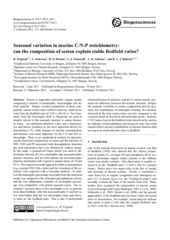| dc.contributor.author | Frigstad, Helene | eng |
| dc.contributor.author | Andersen, T. | eng |
| dc.contributor.author | Hessen, D. O. | eng |
| dc.contributor.author | Naustvoll, L. J. | eng |
| dc.contributor.author | Johnsen, Torbjørn Martin | eng |
| dc.contributor.author | Bellerby, Richard G. J. | eng |
| dc.date.accessioned | 2012-08-09T08:27:36Z | |
| dc.date.available | 2012-08-09T08:27:36Z | |
| dc.date.issued | 2011 | eng |
| dc.Published | Biogeosciences 8: 2917–2933. | en |
| dc.identifier.uri | https://hdl.handle.net/1956/5932 | |
| dc.description.abstract | Seston is suspended particulate organic matter, comprising a mixture of autotrophic, heterotrophic and detrital material. Despite variable proportions of these components, marine seston often exhibits relatively small deviations from the Redfield ratio (C:N:P=106:16:1). Two timeseries from the Norwegian shelf in Skagerrak are used to identify drivers of the seasonal variation in seston elemental ratios. An ordination identified water mass characteristics and bloom dynamics as the most important drivers for determining C:N, while changes in nutrient concentrations and biomass were most important for the C:P and N:P relationships. There is no standardized method for determining the functional composition of seston and the fractions of POC, PON and PP associated with phytoplankton, therefore any such information has to be obtained by indirect means. In this study, a generalized linear model was used to differentiate between the live autotrophic and non-autotrophic sestonic fractions, and for both stations the non-autotrophic fractions dominated with respective annual means of 76 and 55 %. This regression model approach builds on assumptions (e.g. constant POC:Chl-a ratio) and the robustness of the estimates were explored with a bootstrap analysis. In addition the autotrophic percentage calculated from the statistical model was compared with estimated phytoplankton carbon, and the two independent estimates of autotrophic percentage were comparable with similar seasonal cycles. The estimated C:nutrient ratios of live autotrophs were, in general, lower than Redfield, while the non-autotrophic C:nutrient ratios were higher than the live autotrophic ratios and above, or close to, the Redfield ratio. This is due to preferential remineralization of nutrients, and the P content mainly governed the difference between the sestonic fractions. Despite the seasonal variability in seston composition and the generally low contribution of autotrophic biomass, the variation observed in the total seston ratios was low compared to the variation found in dissolved and particulate pools. Sestonic C:N:P ratios close to the Redfield ratios should not be used as an indicator of phytoplankton physiological state, but could instead reflect varying contributions of sestonic fractions that sum up to an elemental ratio close to Redfield. | en_US |
| dc.language.iso | eng | eng |
| dc.publisher | Copernicus Publications on behalf of the European Geosciences Union | en_US |
| dc.relation.ispartof | <a href="http://hdl.handle.net/1956/5933" target="blank">Carbon to nutrient ratios in marine systems: understanding natural variability Studies of seasonal, inter-annual and regional variability</a> | en_US |
| dc.rights | Attribution CC BY | eng |
| dc.rights.uri | http://creativecommons.org/licenses/by/3.0/ | eng |
| dc.title | Seasonal variation in marine C:N:P stoichiometry: can the composition of seston explain stable Redfield ratios? | en_US |
| dc.type | Peer reviewed | |
| dc.type | Journal article | |
| dc.description.version | publishedVersion | en_US |
| dc.rights.holder | Copyright Author(s) 2011. CC Attribution 3.0 License. | en_US |
| dc.identifier.doi | https://doi.org/10.5194/bg-8-2917-2011 | |
| dc.subject.nsi | VDP::Mathematics and natural science: 400::Geosciences: 450::Oceanography: 452 | en_US |
| dc.subject.nsi | VDP::Mathematics and natural science: 400::Zoology and botany: 480::Marine biology: 497 | en_US |

